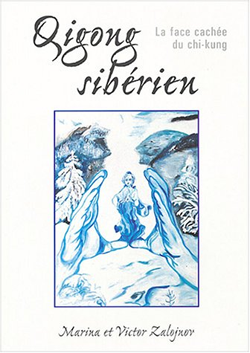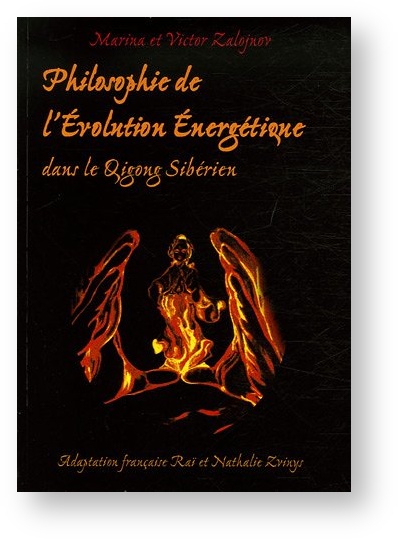Zhen Paï and Siberien Qigong
A synthesis of diverse Energy Arts with Chinese Qi Gong and Taoist traditions
Its principal idea is to enhance the capacity to feel the energy that is present in each one of us, so that manipulating all its diversity becomes evident and clear, almost material.
To feel, to distinguish and to develop the energy within and outside of the body,as well as in nature that surrounds us.To use it for your health and for your personal development.
Read more : Difference of Siberian Qi Gong and other Energy Arts
2. The Human Energetic Body
 As previously mentioned, humans are composed of both matter and energy. Each individual, therefore, has both a physical and an energetic body.
As previously mentioned, humans are composed of both matter and energy. Each individual, therefore, has both a physical and an energetic body.
The Physical body, with which we are familiar, is made up of bone tissues, organic and muscular tissues, and fluids that nourish these tissues and keep them alive.
The Energetic Body, which may be less familiar to us, is twofold – internal and external. The internal energetic body comprises energetic centers and channels inside the physical body and the external energetic body comprises centers and envelopes surrounding the physical body.
The Internal Energetic Body is composed of centers that gather energy and channels that transport it in the same way as the veins and arteries irrigate the physical body.
We can distinguish three types of energy centers – cells, organs and the energetic centers themselves. The latter, the organs’ informational matrixes, are known as chakras in India and ‘Dan Tian’ in China, and depending on the origin of the teaching, there are three; five, or seven of them. We base our analysis on three ‘Dan Tian’ situated in the pelvic area, the chest and the head. (See lesson 4 for more details). The energetic center of an organ, its energetic nucleus, is located within the organ, drawing energy from the organ’s peripheral parts. The nucleus determines both the organ’s energetic and physical form. On a cellular level, the nucleus also plays the role of an energetic center, attracting and diffusing energy.
An individual’s internal energetic body is the sum of the physical body’s various energy fields, including each atom, each molecule and each organ.

Atoms Molecules

Kidneys Heart Brain
Each of these structures, from the smallest pulsation to the general vortex, contributes to the whole system - – and as a whole, they represent the internal energetic body.
The external energetic body comprises an energy field surrounding the physical body (as an apple contains a seed), and which determines its internal qualities.

External energetic body
At the same time, it is composed of and nourished by the energy fluxes emitted by the physical body. This mutual influence is significant in that the external energetic body simultaneously drives the physical body and reflects its state. Its condition depends directly on the state of the physical body and vice-versa. They are interdependent. Each of our organism’s cells is related to a precise part of our external energetic body.
The following section gives a more detailed description of the external energy body.
An individual’s external energetic body is composed of cocoons or envelopes together with energetic and informational centers situated respectively in the Lower Channel and the Upper Channel.

External Energetic Body
The Cocoons of the External Energetic Body
The External Energetic Body comprises numerous cocoons, grouped into several categories. Our external energetic body’s overall structure resembles both an orange and an onion. Like the onion, it is composed of successive layers of energy, known as ‘cocoons’
) In each cocoon, energetic particles circulate between an external and an internal membrane. Thus the term cocoon includes both the membranes and the particles. As we can see in illustration 2-6, adjacent cocoons share a common membrane. (2-6. Shared membranes)

External membrane
Internal membrane
Distribution of energy and information on and between the cocoon’s membranes
The energy circulating between the cocoon’s membranes comes directly from the Lower Channel’s energetic centers. The membranes contain information received from the Upper Channel’s energo-informational centers.
With multiple layers that allow vibrations to pass through, the membranes are like complex computers that process and dispatch information. (For more details on information see chapter 5). Each individual’s membranes are unique: no two people have the same energo-informational identity.
Membranes of the 2-nd cocoon

Membranes of the 1-st cocoon
Common membranes
The external energetic body’s resemblance to an orange comes from its vertical armatures that divide it into sections.

Vertical armatures
Body
The vertical armatures of the exterior energetic body
They stabilize the cocoons, but they also serve as liaisons between the Upper and Lower energo-informational centers. The number of vertical armatures varies from person to person, but most people have eight of them.
The cocoons are also held in place by six horizontal armatures, situated at the height of the temples, the mouth, the clavicles, the diaphragm, the navel and the genitals.

The horizontal armatures of the exterior energetic body
These armatures serve to maintain the cocoons’ elasticity and to transmit information horizontally, either between the cocoons themselves or between them and the physical body. They modify the cocoons’ form or size, adapting them to the individual’s situation (stress, relaxation…). In case of perceived danger, the message “shrink the cocoons” will be transmitted along these armatures, thus reinforcing and protecting the internal energetic and the physical bodies, rendering them less vulnerable.
The cocoons as such are not present at birth, but evolve with the individual’s development. At birth, then, the child lacks an exterior energetic body, and the physiological cocoons, usually four in number, are the first to develop. Until approximately six years of age the child’s physical activity permits him to open, fill and enrich these cocoons. Thus the child generates the energy necessary to irrigate his cocoons. The skin is the interior membrane of our first energetic cocoon, the one that transmits energy to our physical body through exchanges between energetic and physical bodies. The physiological cocoons comprise a dense energy that influences the physical body. The cocoons’ membranes conserve information relevant to the physical body and relay it to the body.
At around six years of age the four psychological cocoons begin to develop, forming the fifth through eighth cocoons. These larger and lighter cocoons provide psychological energy, allowing us to feel our emotions and sentiments. Then around age thirteen, the four mental cocoons begin to form and develop (cocoons nine through twelve). The youth begins to think with ideas, thus opening the mental cocoons progressively until about age twenty-four. Thus ends a phase of opening up. The twelfth cocoon’s membrane is thicker than the others, as it has a protective function, delimiting the material world. The last cocoon, in fact, contains the entire universe and all the material world’s information.
Each one of us contains the entire universe, but we can only experience it if all our cocoons are sufficiently developed. However having spontaneously well-developed cocoons is well nigh impossible. Living provokes deformation or partial destruction of the information inscribed on the membranes. Ten years of Qigong are often necessary to repair, stabilize, and find the original shape the cocoons were destined to have.
Finally, for certain individuals between the ages of twenty-four and thirty-three, exterior cocoons begin their development. These cocoons, necessary for social and spiritual development, are in contact with the egregores (See chapter 6).
While until the age of twenty-four, the development of the physiological, psychological and mental cocoons takes place from the center outwards, for some people another type of development takes over afterwards. Their cocoons will develop in an “egocentric”, “introverted” fashion. They will no longer seek outside information, but will focus on realizing the information within them. The physical body then will receive only echoes of exterior information, and it will mingle the mental cocoons’ activation with that of the others.
This presentation of the cocoons’ spontaneous development according to age groups is, of course, representative and can vary significantly depending on the individual. The construction and development of the cocoons with their inherent membranes is extremely important, and as we will see in more detail in the following chapters, incidents in the course of an individual’s development are not without consequences. After a trauma, for example, if a cocoon cannot find energy to nourish it, it will remain empty. Thus in an extreme case, a person who has developed only his or her physiological cocoons will be interested solely in things related to the physical body. Such a person will seek to fulfill only physical needs, such as hunger, sleep, sexual desire and physical protection—the animal part of his or her nature takes command.

The Energetic and Informational Centers
of the External Energetic Body
These centers are located in our two channels, the Upper Channel, directed skywards, and the Lower Channel, oriented towards the earth. Like two tubes, these wells contain the centers, and their walls connect the centers to one another, permitting the harmonization and unification of the different adaptations occurring at each instant within the centers. The centers serve as filters: those within the Upper Channel analyze and regulate information, while those of the Lower Channel do likewise for energy. There are usually ten centers, five above linked to the five below. Corresponding centers are linked by the cocoons’ membranes, but their communication is also assured by the vertical armatures. By analogy with trees, we can say that the cocoons have their roots in the Lower Channel’s energetic centers and their leaves in the Upper Channel’s informational centers.
The Lower Channel’s centers receive and adapt energy from the outside. They then fill the cocoons with this transformed energy. Each center has its own specificity and its own energetic spectrum. They all quickly react to the slightest change in our physical activation. Depending on a person’s development, certain of his or her lower centers will have more energy, and will be more active than others.
The Upper Channel’s centers, which are very sensitive to information from the outside, serve as filters, centers of decision that, when necessary, rapidly send and distribute information to the membranes of the cocoons to which they are connected. In the Upper Channel, the “higher” centers can transmit certain information that corrects and enriches that of the centers beneath them. This process uses the adjacent membranes of the different cocoons. The opposite process occurs with the energetic centers of the Lower Channel.
When a “higher” center of the Upper Channel is weak, it does not filter well and can send on too much information to the center just below it. Inversely, in the Lower Channel, a lower center can keep energy from rising to the center above it. The system is very subtle, and stress can easily perturb the centers’ functioning. Thus for example, if someone’s first informational center (the cerebellum) is no longer able to assimilate the information that descends through the Upper Channel, that person’s body will gradually become more and more energetic. The membranes of his or her physiological cocoons are deprived of information since they can no longer absorb it, and as a consequence the cocoons swell with an excess of unused energy. Progressively this person will no longer be able to react to situations in an informational way, for instance to send signals to his or her immune system. The body’s systems become weaker and more and more passive. Because of this large energetic reservoir, with no informational functions to utilize it, the person will begin to gain weight. On the other hand, for someone with a blocked energy center but very active informational functioning, that person will consume his or her energy in nourishing these functions and will begin to lose weight. We will examine the concept of information and the dialectic relationship between information and energy.
Let us now examine the characteristics of the external energetic body. Man’s outer energetic body is a vortex of energy, a torrent in perpetual motion. It weaves a distinctive network of interactions with its surroundings; thus it is linked by a series of threads to galaxies, planets, cities, houses, to the arts, to men, food, clothing …

Energy of the physical body
and the inner energetic body
Energy of the physiological cocoons
Energy of the psychological cocoons
Energy of the mental cocoons
Movements of the different vortexes that make up the outer energetic body
This network or web determines each person’s specificity. Normally when an individual is in good health, his or her outer energetic body’s energy moves and rotates constantly. This vortex’s movement and rotation vary considerably: on the one hand linked to the body’s condition and internal rhythms, and on the other based on its interactions with the surrounding energetic fluxes or the influence of exterior rhythms, such as those of the planets, the climate, other people… The more numerous the active vortexes in contact with a person’s outer energetic body, the greater the stimulation of his or her internal movements, intensifying the vibrations of the matter in certain parts of the body, or in certain inner energetic centers. This has the consequence of bringing the person more vitality, mobility, force and stability.
The blossoming of flowers
Future workshops
Visitors Map















